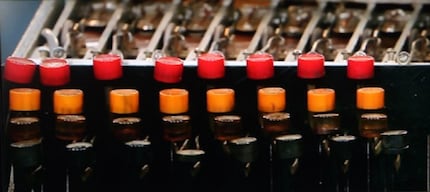
Background information
Interview with Elizabeth Olsen: «I don’t know what’s next for me after ‘Doctor Strange’.»
by Luca Fontana

Premise, dramatisation, punchline, laughter. I don’t mean me laughing in front of the telly, rather a track in the show itself. A lot of sitcoms use laughter tracks – even the same ones since 1950.
As I don’t use linear TV anymore, I haven’t been watching any sitcoms. That was until last week when I switched on «One Day at a Time» (site in German) on Netflix. In the almost half-hour episodes, I observe a Cuban-American family’s problems and see what happens next. Conceptually speaking, it’s nothing new. And there’s another element in this concept that I’d almost forgotten about. Namely, that laughter is cut in from the start.
But why?
Before TV and radio, shows could only be followed collectively. Either at the theatre, opera or, later on, the cinema. Everyone in the audience noticed the reaction of others in the room. They didn’t want to lose this feeling just because, with the advent of radio, people began followed everything from their living room. This meant shows were recorded with a live audience – including the laughers, non-laughers and too-loud laughers.
But it was demanding. Bing Crosby, for instance, hated live recording his radio show, which was sponsored by cigarette brand Chesterfield. And having to do it twice. Once for the east coast and then again for west coast prime time. Jack Mullin, an electrical engineer, put forward a German workaround. Shortly after the capitulation of the Nazi regime, Mullin – who was stationed in Germany as part of the American signals corps – visited the Radio Frankfurt studio. A British soldier enthused about the tape recorders used there to broadcast orchestral concerts day and night.
Mullin took two of these AEG magnetophones to the USA, where he worked for Crosby from summer 1947. These devices allowed him to record his show. When Bob Burns, a hillbilly comic, was telling risqué jokes during one of these recordings, he may have cashed a lot of laughs for them, but the jokes had to be cut out. The audience’s reaction, on the other hand, was kept in. And it was used again a few weeks later when an act didn’t get the laughs they’d wanted.
And that’s when canned laughter was born.
These were soon used in television as well. Sitcoms were (and these days still are to a certain extent) filmed in front of a live audience. But as there was only one camera, individual scenes had to be recorded a number of times to capture different angles. That had an impact on the audience’s reaction. By the third go, a punchline would garner at best a weary smile. And even in the first take, there’d be some laughter in the wrong places or some laughs that went on too long. Sound engineer Charles Douglass (site in German) didn’t like this and started to work on cutaway laughter.
From the 50s to the 70s, Douglass had a monopoly over laughter tracks in American TV. This was down to the machine he’d built that had 320 different laughs on it. He played the keys like an organ to create would-be authentic laughter. He popped up in all the large studios with his invention, charging 100 dollars per episode. The «Laff box» had such an influence on the sitcom landscape that Douglass was even honoured with an Emmy in 1992.

It wasn’t until the 90s that «HBO» started to dispense with laughter tracks. Their shows «Dream On» and «The Larry Sanders Show» proved that it was possible to produce good comedies without canned laughter. Other studios followed their lead, as it offered more freedom in writers’ rooms. Programmes no longer had to follow the pattern of punchline after punchline for a concept to work.
Sitcoms such as «Malcolm in the Middle», «Scrubs», «The Office» and «Curb your Enthusiasm» don’t rely on canned laughter. Part of the reason being they’re filmed differently. They’re what’s known as single-camera series, which is the leading filming method these days. It means a show is always filmed with one main camera (but not that only one camera is used). This makes the image look more cinematic and offers increased filming options.
By contrast, sitcoms with a live audience are filmed in multi-camera set-ups. This involves shooting from several different angles with actors moving about as though they’re on a theatre stage. Series such as «Friends», «The Big Bang Theory», «2 Broke Girls» and «The King of Queens» are filmed like this – and they all use laughter tracks to optimise real laughs.
However, there are exceptions. Take «It’s Always Sunny in Philadelphia», for example, which was filmed in multi-camera style but doesn’t use any canned laughter. The converse is true for «How I Met Your Mother», which wasn’t filmed in front of a live audience but still opted for a laughter track.
Even today, the same laughs as those from Douglass’s «Laff Box» are often used. The reason being that audiences find them familiar, making it quicker to evoke a reaction. So, when I’m all cosy on my sofa and switch on «One Day at a Time», I’m probably laughing along with people who are already dead.
Thumbnail image: Warner Brothers
My life in a nutshell? On a quest to broaden my horizon. I love discovering and learning new skills and I see a chance to experience something new in everything – be it travelling, reading, cooking, movies or DIY.
Interesting facts about products, behind-the-scenes looks at manufacturers and deep-dives on interesting people.
Show all
Background information
by Luca Fontana

Background information
by Carolin Teufelberger

Background information
by Luca Fontana